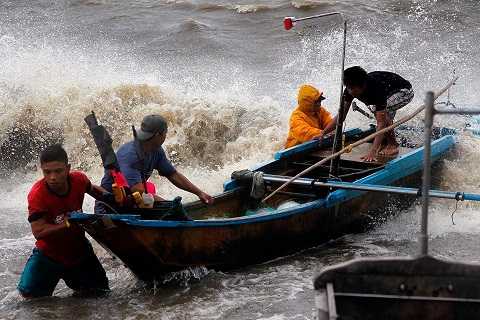
Fishermen secure their boat as strong winds brought by Typhoon Haiyan pound Los Banos, Laguna Lake, Philippines on November 8 (Photo by Jimmy A. Domingo)
The island of Salvacion in the Philippine province of Samar is a wasteland. Three weeks after Super Typhoon Haiyan, no trees are left standing, the houses are without roofs and there is nothing but debris on the ground.
People wander around, some aimlessly, looking for something to do. Some wash muddied clothes, others dry whatever is left of their belongings in the hot sun.
San Antonio in Basey town used to be a bustling fishing village with a population of 2,646 before the typhoon struck the central Philippines on November 8. At least 52 people on the island were reported to have been killed.
"All is lost," says Adelardo Ocop, the village head. But he says they are not asking for more than what they need to survive.
"We need to have our boats again, our fishing nets. That would be enough. We’ll continue fishing to sustain ourselves here," he says.
Ocop says people on the island cannot afford to rely solely on the relief supplies of rice, canned sardines and water that they receive every two days from the government.
"We can't depend on relief handouts. They will not last long," the village head says. "We need to sustain ourselves here on the island."
Humbert, a fisherman, says people need financial assistance quickly to start anew and rebuild their homes.
He says some of his neighbors are planning to leave the island for good if they do not receive assistance from the government. Humbert worries about them.
"Many of us here have no formal education. What will happen to us in the city? There is a better chance for us to survive here," he says, adding that he will stay to set an example.
Robert Castañares, the head of Eastern Visayas region’s Chamber of Commerce, believes the government should prioritize agriculture alongside the rebuilding of critical infrastructure in the affected areas.
"Considering that 90 percent of the population depends on agriculture for their livelihood, the rehabilitation of the sector will have the greatest impact in terms of recovery," he says.
He says agriculture is the "easiest to rehabilitate" because the main resources - the land and the sea - are still intact.
The region’s main crops are rice and coconut, which comprise about 70 percent of the total agricultural output in terms of value.
According to the Agriculture Department, the total area of rice fields ravaged by Haiyan is 16,000 hectares.
The total amount needed to replant this rice would be about US$800,000. Castañares says about US$17 million would suffice for new equipment to get the fishing industry back on its feet, assuming that 40 percent of the island’s fishermen were affected by the typhoon.
Replacement costs for damaged crops and fishing equipment for fishermen are therefore, according to Castañares, relatively inexpensive on a per capita basis.
Until and unless that funding becomes available, the future for Samar looks gloomy.


